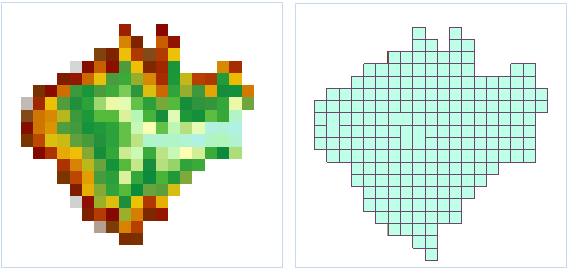raster to vector
Instructions for use
Vectorize raster data type to convert raster datasets into point, line, or region datasets.
Open the "Terrain" data source in the "ExerciseData/RasterAnalysis" folder, which contains DEM data with a resolution of 100 meters. We will use this data as an example.
Function Entries
- Spatial Analysis tab -> Raster Analysis group -> Vector-Raster Conversion -> Raster to Vector.
- Toolbox -> Raster Analysis -> Vector-Raster Conversion -> Raster to Vector.
Parameter description
 |
| Figure: Raster to Vector Result |
- In the "Source Dataset" area, select the dataset to be processed.
- Datasource: In the dropdown list on the right, all data sources in the current workspace are listed. Select the data source containing the raster dataset to be vectorized.
- Dataset: In the dropdown list on the right, all raster datasets and image datasets in the selected data source are listed. Select the dataset to be vectorized.
- In the "Result Data" area, set the location and name of the result dataset generated after vectorization.
- Datasource: Select the data source location to save the result dataset generated by vectorization.
- Dataset Type: Select the dataset type generated by vectorization, which can be a point dataset, line dataset, or region dataset.
- Dataset Name: Name the result dataset generated by vectorization.
- The parameters in the "Vector Line Settings" area are only effective when the "Dataset Type" in "Result Data" is selected as "line dataset".
- Smoothing Method: Only effective when converting raster to vector line data. Options include "B-Spline" or "No Processing". For more details on the smoothing process, refer to the Smoothing Method Description document.
- Smoothness: Only effective when converting raster to vector line data and the smoothing method is B-Spline. The valid range of smoothness depends on the smoothing method. When using B-Spline, no smoothing occurs if smoothness is less than 2. Higher smoothness values result in smoother vector lines.
- Thin Raster before Conversion: Select this option to thin the raster data before vectorization. Thinning reduces the number of cells representing linear objects in raster data, improving vectorization speed and accuracy. For example, a scanned contour map may use 5-6 cells to display a contour line width; after thinning, only one cell is used. You can pre-thin grid/image data before vectorization. For details on raster thinning, see Raster Thinning.
- The parameters in the "Raster Settings" area are only effective when vectorizing raster datasets and do not apply to image datasets.
- No Value: For raster datasets, cells with pixel values set to this value are considered no-value data and excluded from vectorization.
- No Value Tolerance: After setting the "No Value" pixel value, set this tolerance. Cells with pixel values within the tolerance range of the "No Value" setting are excluded from vectorization.
- Raster Value Field: Stores the raster value of each cell into a field in the result dataset. The field name is specified in the following text box. The default field is "value".
- Convert Specified Value Only: Extract only regions with cell values equal to the set value for vectorization.
- Raster Value: Cells with pixel values set to this value participate in vectorization.
- Raster Value Tolerance: Set the tolerance range for the specified "Raster Value". Cells with raster values within the floating tolerance range participate in vectorization.
- The parameters in the "Image Settings" area are only effective when vectorizing image datasets and do not apply to raster datasets.
- Background: For image datasets, cells of this color are treated as background and excluded from vectorization.
- Background Color Tolerance: After selecting a background color for an image dataset, if a cell's RGB values fall within the floating tolerance range of the background color, it is also treated as background and excluded from vectorization. The tolerance value applies to all three RGB values. For example, with a tolerance of 10, color values within (R±10, B±10, G±10) are within tolerance. Tolerance ranges from 0 to 255.
- Environment Settings: Set analysis environment parameters. Raster to vector supports parameters such as geographic range of result dataset, clip bounds, and default cell size. For specific operations, refer to the Setting Analysis Environment page.
Note: Environment parameters can be set as global, meaning these settings become the overall raster environment analyst parameters. Other functions supporting environment parameters do not need repeated settings. If not set here, the analysis reads the parameter settings from the raster analysis environment.
Related Topics



